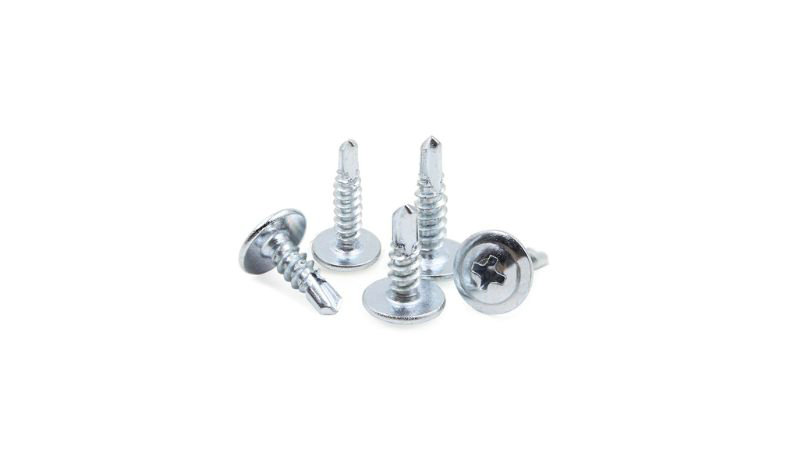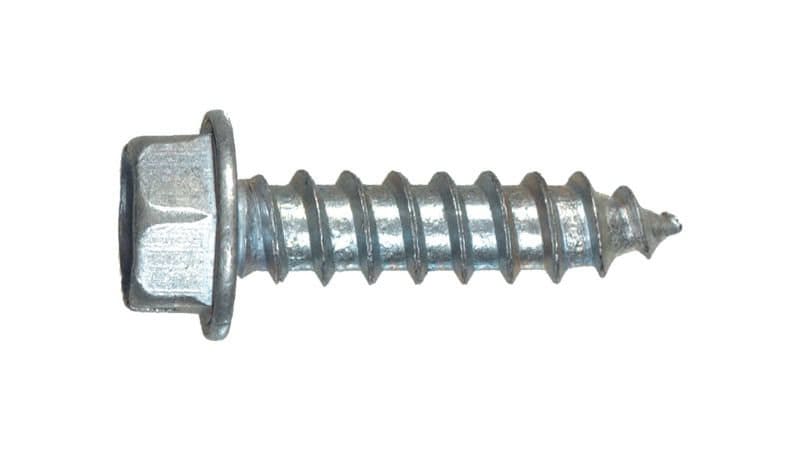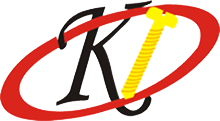
When it comes to fastening thin metal sheets and other materials, sheet metal screws are the go-to choice for professionals and DIY enthusiasts alike. But what exactly is a sheet metal screw, and how does it differ from other types of screws?
In this comprehensive guide, we’ll dive into the world of sheet metal screws, exploring their unique features, various types, and the numerous applications they serve.
What is a Sheet Metal Screw
A sheet metal screw, also known as a hex washer, is a specialized fastener used to fasten pieces of sheet metal to other metal objects or to attach sheet metal to other surfaces like plastic, aluminum, plywood, hard rubber, or wood.
Different from wood screws, sheet metal screws have consistent, tighter, and sharper fully threaded shafts that cover the entire length / shank which allows them to more efficiently tap threads in the metal.
Sheet metal screws can be categorized by screw head style and dimensions. The head style includes:
- Flathead: Sits flush with the surface.
- Pan head: Raised slightly above the surface.
- Oval head: A combination of flat and pan, creating a more decorative finish.
- Truss head: Extra wide head with a rounded top. Low height, casts a little shadow and requires little space.
- Hex head: Allows for greater power transmission and reduces stripping.
Different Types of Sheet Metal Screw
There are two types of sheet metal screws: self-driving screws and self-tapping sheet metal screws. These two types of screws are used in different ways.
- Self-tapping screws (Type A, AB, and B): This kind of screw is ideal for applications with a pre-drilled hole. Its sharp tip helps drive the screw through the metal, and the threads tap into the hole.
- Create their own threads as they are driven into the material, eliminating the need for a separate tap
- Type A has coarse threads, Type B has finer threads than Type A for use in thinner sheet metal, while Type AB has fine threads for broader functional capabilities
- Self-drilling screws (TEK screws): Self-drilling screws allow them to penetrate and tap into metal without pilot holes because of the drill tip they have.
- Feature a drill point tip similar to a drill bit that drills its own hole and forms threads simultaneously
- Available in TEK 2, 3, 4, and 5 sizes to pierce through various gauges of metal (20 to 14 gauge)
- The higher the TEK number, the larger the drill point for heavier gauge metals
- Best utilized with a high-speed impact drive in most cases
The Size and Length of Sheet Metal Scews

The size of sheet metal screws ranges in size from #0-#14 in diameter. The common sizes are #4, #6, #8, #10, #12 from small to large.
Here’s a quick reference for screw diameters (in inches):
| rew Size | Diameter (Inches) | Diameter (mm) | Threads per Inch |
|---|---|---|---|
| #0 | 0.060″ | 1.52 mm | – |
| #1 | 0.073″ | 1.85 mm | – |
| #2 | 0.086″ | 2.18 mm | – |
| #3 | 0.099″ | 2.51 mm | – |
| #4 | 0.112″ | 2.84 mm | 40 |
| #5 | 0.125″ | 3.18 mm | – |
| #6 | 0.138″ | 3.51 mm | 32 |
| #7 | 0.151″ | 3.84 mm | – |
| #8 | 0.164″ | 4.17 mm | 32 |
| #9 | 0.177″ | 4.50 mm | – |
| #10 | 0.190″ | 4.83 mm | 24 |
| #12 | 0.216″ | 5.49 mm | 24 |
| #14 | 0.250″ | 6.35 mm | 20 |
| 5/16″ | 0.3125″ | 7.94 mm | – |
| 3/8″ | 0.375″ | 9.53 mm | – |
Material and Durability
To suit various applications and environments, sheet metal screws are made from different materials. Here are some commonly used:
- Stainless Steel: Ideal for outdoor or moist environments due to high corrosion resistance. Different grades of stainless steel are available, like 410 magnetic and 316 marine grade.
- Hardened Steel: Generally used for high-stress applications or fastening harder materials like harder gauge steel.
- Aluminum: Aluminum sheet metal screws are lightweight but still have a good behavior on corrosion.
- Brass: They are often used in decorative applications.
- Nylon: Nylon or plastic sheet metal screws are lightweight, non-conductive, and resistant to chemicals. They are suitable for applications where electrical insulation or resistance to certain substances is required.
- Other less common materials mentioned include rubber (Buna-N, Neoprene), which may be used in specialized applications requiring flexibility or sealing properties.
How to Install the Sheet Metal Screws and Where to Install?

You will find the essentials of sheet metal screws when working with various materials in construction, HVAC, or manufacturing. The installation process typically involves creating pilot holes and understanding the compatibility of the screws with different materials to ensure structural integrity and meet load requirements.
Pre-drilling Pilot Holes
Creating pilot holes is a vital step that often determines how well the screws will perform. A pilot hole provides a guide path that helps to ensure the screw enters the material accurately and reduces the risk of damaging both the screw and the material.
For creating pilot holes, consider these tips:
- Material Thickness: Adjust the size of the pilot hole to match the material thickness; thinner materials require smaller pilot holes.
- Screw Size: Use a drill bit slightly smaller than the screw diameter to create a snug fit.
- The hole depth should be at least equal to the screw length.
- If attaching to wood, the hole should not extend into the second piece of wood, ensuring the threads can grip.
Choosing the Right Size
- Light-duty applications: Use smaller sizes such as #4 or #6 screws for thin materials.
- Medium-duty applications: #8, #10, or #12 screws are preferred for fixtures and hardware.
- Heavy-duty applications: Larger screws provide increased retention in demanding environments.
Applications of Sheet Metal Screw
- HVAC and Ductwork
- Fastening sheet metal components in heating, ventilation, and air conditioning systems
- Securing ductwork and air handling equipment
- Construction and Roofing
- Attaching metal roofing panels and flashing
- Fastening metal studs, tracks, and framing components
- Securing metal siding and trim
- Electrical and Electronics
- Mounting electrical components, junction boxes, and panels
- Fastening metal enclosures and chassis for electronic devices
- Automotive and Transportation
- Attaching body panels, trim, and interior components in vehicles
- Securing metal parts in trailers, RVs, and other transportation equipment
- Furniture and Cabinetry
- Fastening metal hardware, hinges, and brackets to wood or metal furniture
- Attaching metal drawer slides and other cabinet components
- Appliances and Equipment
- Securing metal panels and components in household appliances
- Fastening metal parts in industrial machinery and equipment
- Signs and Displays
- Mounting metal signs, nameplates, and logos
- Attaching metal frames and supports for displays and exhibits
- DIY and Home Improvement
- Fastening metal shelving, racks, and storage systems
- Attaching metal trim, molding, and decorative elements
- Securing metal hardware in various home improvement projects
- Marine and Outdoor Applications
- Fastening metal components in boats, docks, and other marine structures
- Securing metal parts in outdoor furniture, playground equipment, and fencing
- General Fastening and Assembly
- Attaching metal pieces to other metal objects
- Fastening metal to plastic, aluminum, plywood, hard rubber, or wood surfaces
Frequently Asked Questions
What are the benefits of using a type AB sheet metal screw?
Type AB sheet metal screws have fine threads and gimlet points, offering more precision and hold in fragile materials. They are versatile and provide increased holding power compared to Type A.
How do sheet metal screws compare in strength to wood screws?
Sheet metal screws are generally made to handle thinner and more malleable materials than wood screws, which are specifically designed to grip wood fibers. Thus, wood screws may provide a stronger hold in wood applications.
